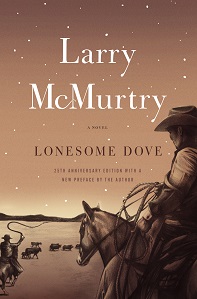I discovered Lonesome Dove on a bookshelf at work a few years ago. I was about to go to Texas on vacation and figured it might make for good atmospheric reading. Although it had, to my mind, acquired a somewhat cheesy reputation, and I had never much enjoyed Westerns anyway, I picked it up and brought it with me—and was immediately engrossed from the airport onward. The writing was everything I always wished Cormac McCarthy’s neo-Westerns would be: sharp, flowing, wry, poignant—yet never too full of itself, and never above the feelings he generates. Larry McMurtry’s wonderful gift is his ability to create expansive portraits with a remarkable scarcity of language. The book is over eight hundred pages long, but the words on the page are precise and to the point. He never uses more than he needs in order to put the look and feel and even taste of the American West into one’s mind. It is truly a perfect reading experience, a book for people who want to be swept away.
In short order, I knew exactly the personalities at work in Gus, Call, Jake, Lori—and those plucky pigs. As the New York Times wrote of the book, “These are real people, and they are still larger than life.” The characters in these pages are fully formed, and yet not given to us so easily. One of the most fascinating things about the book is how much it holds back from telling you what anyone is feeling or thinking; in another book, it would be incredibly frustrating, but here, it simply adds to the mystery of human action, an ongoing and fraught question within Lonesome Dove.
Lonesome Dove is an epic read in the tradition of Homer: a story about hardship, the worthiness and sometimes foolhardiness of being brave, the valor of the American warrior known as the cowboy, the end of the West, the fierce ties that bind people together, and the finality and unpredictability of death. It is a searing book, and worth revisiting.








